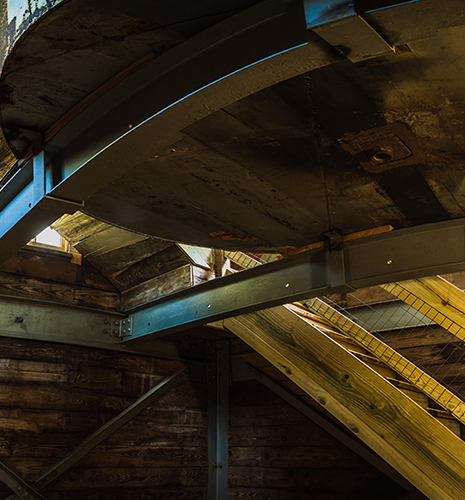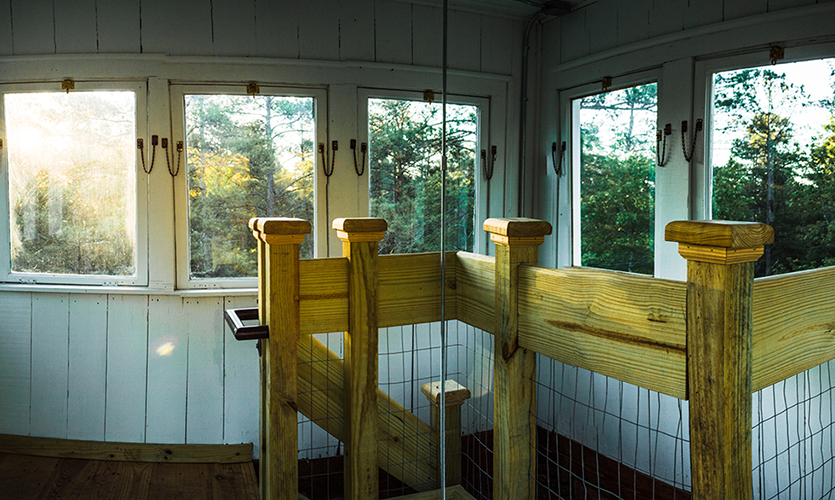A.H. Stephens State Park Observation Tower Restoration
Georgia Department of Natural Resources

Projects > A.H. Stephens State Park Observation Tower Restoration
Georgia Department of Natural Resources
Design Award:
The Georgia Trust for Historic Preservation | Preservation Award: Excellence in Preservation | 2019
Conveniently located a few miles off of I-20 in Augusta, Georgia, A.H. Stephens State Park is best known for its equestrian facilities, lakeside group camp, and historic Civil War museum. The 1,177-acre park, which was named after the former Georgia Governor, A.H. Stephens, encompasses three lakes, four cottages, and 25 campsites.
In 2015, SSOE was brought in to restore the park’s famous Civilian Conservation Corporation (CCC) Observation Tower, originally built in 1935. The 60-foot three-story observation tower, equipped with a 3,500-gallon tank, experienced a variety of deteriorating factors such as erosion, water intrusion, and rotting siding, roof boards, and window openings. Additionally, the building, which lacked the appropriate insulation, had no mechanical ventilation system, which, according to the team, sped up the degradation process. Project scope also included rebuilding the staircase and renovating the ground floor as an interpretive area.
Since its construction and eventual decommission as a fire watchtower, the structure served different purposes. These changes in function, each with their own general wearing effects on the building, eventually led to the issues the design team was asked to correct – challenges the team successfully addressed. The biggest challenge – tucking the new staircase into the existing tower structure. Not only did the staircase conflict with the existing steel water tank but it also had to compete with the inward tilt of the tower walls. As the tower increased in height the walls tapered inward as well, which required the staircase to be set in further at each landing.
One of the more severe issues included water intrusion. Once water damage began to break down the exterior surfaces of the tower, local wildlife began to take advantage – i.e. birds, wasps, and an endangered species of bats. As part of the restoration process, the team replaced all damaged exterior wood boards, windows (matching the profile of their historic predecessor), replaced all window flashing, repainted the exteriors, and caulked around all gaps in the exterior walls. A new synthetic shake roof with a new plywood substrate, a roofing membrane, and metal step flashing was also installed. Synthetic roof shakes were used to provide longer maintenance-free protection while also matching the historic context of the building.
At the ground floor, the interior wood ceiling and wall planks were replaced where damaged, the concrete floor was protected with a new coat of epoxy paint, and ADA requirements for accessibility into the structure were provided. In addition, the team was asked to create a welcoming interpretive area that the public could enjoy. To accommodate this request, new flexible track lighting was provided for future interpretive installations, along with general and emergency lighting.


Have a question regarding our services? Need assistance with an upcoming project? Send us an email. We look forward to hearing from you and will follow up soon.
© SSOE GROUP 1948-2025
Legal | Privacy Policy | CA Privacy Policy | Cookie Policy
Website designed and developed by
Raincastle Communications, Inc.
Autodesk Construction Cloud (ACC) is SSOE’s enterprise-wide project delivery platform. We partner with the Autodesk Product team and have research access. Use of the AI Assistant allows our design teams, owners, and general contractors the ability to query the project specifications for quality, answers, and more rapid responses to RFIs, submittals, or issues.
SSOE has developed a proof-of-concept to use an AI Agent to act as a Master Engineer and Architect trained in SSOE’s processes, best-known-methods, and trainings. Our data structure is being remodeled to enable better use of our proprietary knowledge to train the agent on the ‘SSOE way’.
SSOE is actively piloting AI Chat large language models (LLMs) or copilots that use Natural Language Processing (NLP) to streamline both design and development tasks, transforming how our teams interact with software and each other.
By integrating chat LLM engines into platforms like Revit, we’re enabling users to prompt complex actions using simple, conversational commands. In Revit, this means automating tasks such as modeling elements, cleaning up parameter data, managing annotations and dimensions, and organizing sheets—without writing scripts. These automations and quality prompts can be shared across project teams, accelerating workflows and reducing manual effort.
Similarly, our internal Software Development Community is leveraging GitHub Copilot to expedite coding tasks. Developers can generate and refine code using NLP prompts, tapping into GitHub’s extensive Repo to move faster from concept to implementation.
Together, these tools represent a shift from traditional, expert-driven scripting to intuitive, AI-assisted automation, unlocking new levels of efficiency and scalability across our projects.
We helped our client visualize and optimize façade design for occupant comfort—long before breaking ground through the use of the Autodesk Forma tool. It allows the designer to rapidly experiment with the building’s geometry and façade design to promote sustainability, prioritizing quality of spaces and comfort for end uses, especially in extreme climates (daylighting and microclimate analysis tools) at the project’s exact geographic location, using location-specific environmental data.
Discover how SSOE is using Autodesk Forma to improve sustainability outcomes for industrial projects: SSOE Group: Improving sustainability outcomes for industrial projects with Autodesk Forma.
SSOE is utilizing Microsoft Copilot Edge and M365 to significantly enhance work efficiency and accuracy across various departments. Copilot is accessible to all staff after training. Key areas of application include using it as a writing assistant, for idea generation, document summarization and generation, research assistant, excel assistant, programming code assistant, language translations, product comparison and data analysis. Use of Copilot has become part of the everyday life of SSOE employees who have identified key ways it can help them become more efficient with their daily tasks as well as more accurate in their deliverables.
Today, 100% of SSOE employees have taken the voluntary training and have access to Copilot Edge, achieving early our October 1, 2025 goal.
We found ourselves in need of a more robust tool to enhance resource forecasting and staff assignment capabilities. Instead of waiting for the perfect tool, we’re building it. SSOE’s in-house technology team has developed and piloted a tool that aims to forecast optimal staff mix and duration for new projects against existing workload to better understand capacity and manage resources efficiently. Additionally, the tool will allow teams to identify gaps to optimal staff mix.